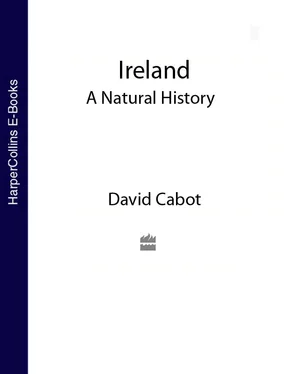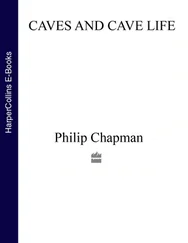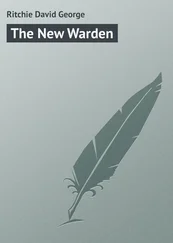Some 58 km further southeast on the high Garron plateau, sitting behind Garron Point on the Antrim coastline, there is an extensive tableland of bare and desolate blanket bog at an elevation of 305–366 m. The bog is deep and wet with many pools and small lakes. Growing here is the rare marsh saxifrage which has bright yellow, often red-spotted, flowers. It was formerly recorded from eight sites in Ireland, spread though six counties. Since 1970 it has only been recorded at this location, at three sites close together on the Nephin Beg Range, Co. Mayo, and at a mineral flush in the wet blanket bog near Bellacorick, Co. Mayo. It is also in decline in Britain. 16,35On the Garron plateau it grows at a mineral flush, fed by a spring arising from the basalt rocks, and surrounded by the moss Drepanocladus revolvens. Other associated species are daisy, bogbean, selfheal, sharp-flowered rush, bog-sedge, glaucous sedge and large yellow sedge.
Garron Bog is also the home of two rare alpine sedges that grow at about 300 m in the area southeast from the Falls, in the upper Glenariff River to Trosk, high above the village of Carnlough. The few-flowered sedge occurs fairly commonly over a large area – at about 20 stations – extending over at least two 10 km squares of the national grid. It is a loosely tufted, creeping and mat-forming sedge with a shortish stem, up to 25 cm high and bluntly three-sided. The flowers are on a single bractless spike. First discovered by the Rev. H. W. Lett in 1889, this is one of only two Irish locations, the other being a watery peatland site on the edge of the Red Moss of Kilbroney, a somewhat miniature Garron plateau, at an altitude of 340 m on the Mourne Mountains behind Rostrevor, Co. Down. 34The other sedge is the tall bog-sedge – first found by Miss Elinor D’Arcy in 1901 when she was only 11 years old – well-established on Garron Bog at several sites near pools, where it grows with Sphagnum moss and other sedges. Its leaves are 2–3 mm wide and its stems reach up to 40 cm. Until 1981 the Garron site was thought to be the only place where it grew in Ireland but then another location was discovered in an upland blanket bog in Co. Tyrone where it was growing on the west side of Lough Carn. It was later discovered in 1985 at Mill Lough, near Lough Fea and also at Lough Ouske, Co. Derry. 34
Sperrin Mountains, Co. Tyrone, manifesting erosion of the shallow peats.
Sperrin Mountains, Counties Tyrone and Derry
The Sperrin Mountains are made up of old rocks, mainly schists and gneisses in the northern parts, with Old Red Sandstone and a little limestone in the southern sections. The area is covered by upland blanket bog with a series of summits each rising to the region of 610 m. This is where the cloudberry was first found in 1826 by Edmund Murphy and Admiral Jones. It was growing in a single patch on a north-facing slope of wet blanket peatland at an altitude of about 533 m, west of the Dart Mountain summit. Today it flourishes almost submerged in the surrounding vegetation. 36A member of the rose family, it is a small, blackberry-like plant with a white flower – a low, downy, creeping perennial spreading vegetatively by rhizomes. It is described as a ‘shy flowerer and fruiter’ in Ireland as it seldom, if ever, sets fruit. This is thought to be due to the overwhelming presence of plants of a single sex – the stamens (the male organ consisting of a filament and a pollen sac called the anther) usually set in a ring outside the flower centre, and styles (columns of filaments arising from the female organs terminating in the stigma receptive to pollen), usually located within the ring of anthers in the flower centre, are borne on separate flowers that are located in many separated single sex patches.
The Mourne Mountains, Co. Down
The Mourne Mountains stand up as a group of granite hills in south Co. Down with some flanking Silurian rocks. Carlingford Lough lies to the south. Many summits exceed 600 m, and the highest point is Slieve Donard at 850 m. Amongst the granite outcrops are some impressive cliffs and dramatic pinnacles that have originated by longer periods of weathering of the rock. Blanket bog covers the uplands and where the Silurian slates have been worn down by the weather, producing a richer soil, more interesting plants occur. The arctic-alpine and alpine flora is disappointing – already we are on the eastern coast of Ireland – and consists of the usual run-of-the-mill species. Amongst the plants of the higher ground, recorded by Praeger, are alpine saw-wort, dwarf willow, cowberry and alpine clubmoss. Lower altitudes host starry saxifrage, roseroot and the parsley fern. On the high cliffs of Slieve Bignian and Eagle Mountain Praeger recorded the very rare native form of the rosebay willowherb. 3It was still at the latter site in 1985 at an altitude of 455 m. 34Also at the high altitudes are the brittle bladder-fern and the stag’s-horn clubmoss with its long and decorative ‘antlers’.
The Galty Mountains, Counties Tipperary and Limerick
The Galtys were thrust up during the dramatic Hercynian earth movements some 300 million years ago that were also responsible for creating the mountain ranges of the southwest of Ireland. This large crustal upfold has been worn down over millions of years. First the uppermost limestones were stripped off the summits, to survive only in the surrounding plains; next, the Old Red Sandstone was eroded along the crest to reveal the old Silurian rocks at the core of the upfold. Thus, the upper parts of the Galtys are made up of Silurian slates, shales and conglomerates to form a series of fine conical peaks that climax at 919 m on Galty Mountain. The bulk of the mountains rise above 762 m. The outstanding arctic plant of the Galtys is the northern rock-cress found at 293 m on a rock buff west of Lough Curra. This and the Glenade cliffs, Co. Leitrim are its only sites in Ireland. It rarely flowers on the Galtys. The best area for the mountain species, according to Praeger, are the cliffs over Lough Muskry. 3Investigating the area before him, the intrepid Hart found the arctic-alpines roseroot, starry saxifrage and mountain sorrel. 37
Mountain fauna
The fauna of Irish mountains and uplands contains very few surprises and, like the flora, is somewhat impoverished. None of the mountain ranges are high or extensive enough to provide the habitats for the true mountain species of birds such as are found in the Scottish Highlands – the ptarmigan, snow bunting and the dotterel. Even when it comes to invertebrates, especially the better investigated groups of butterflies and moths, the range of species is not one to go wild about. However, some interesting discoveries of relict arctic-alpine aquatic beetles have been made which might suggest that they survived the glacial phases of the Ice Age in some of the ice-free mountain summits. Here we will look more closely at the characteristic mammals, birds and invertebrates of mountain and upland areas.
Mammals
The largest living quadruped in Ireland is the red deer which is essentially a creature of the mountains and uplands. While there are several herds and scattered groups throughout the country, the deer in the Killarney Valley area, Co. Kerry, are probably the only ones with a claim to represent the native deer that roamed Ireland during the postglacial period. Once abundant throughout the country as a truly wild species, several herds managed to survive in the more remote areas of Erris, Co. Mayo, Connemara, Co. Galway, and in the Galty Mountains, Counties Tipperary and Limerick, until their extinction in the mid-nineteenth century (see here). Testimony of their once widespread distribution in Ireland is evidenced by the incorporation into numerous place names of the Irish word fiadh meaning ‘deer’. For example, Cluain-fhiadh , ‘the meadow of the deer’, is a parish in Co. Waterford, and Ceim-an-fhiaidh, ‘the pass of the deer’, marks the route taken by these animals when moving from valley to valley of the Lee and Ouvane areas in Co. Cork.
Читать дальше












